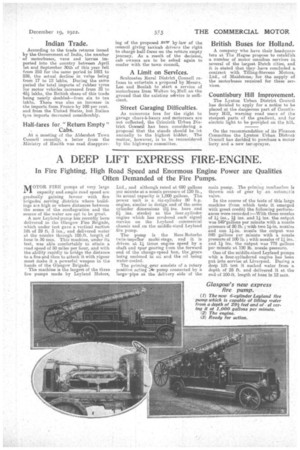A DEEP LIFT EXPRESS FIRE-ENGINE.
Page 9

If you've noticed an error in this article please click here to report it so we can fix it.
In Fire Fighting, High Road Speed and Enormous Engine Power are Qualities Often Demanded of the Fire Pumps.
MOTOR FIRE pumps of very large capacity and ample road speed are gradually gaining favour with fire brigades serving districts where buildings are high or where distances between the scene of the conflagration and the source of the water are apt to be great. A new Leyland pump has recently been delivered to the Glasgow Fire Brigade, -which under test gave a vertical suction lift of 29 ft. 3 ins., • and delivered water at the nozzles through 100-ft. length. of hose in 50 sees. This machine, under its test, was able comfortably to attain a read speed of 50 miles per hour, and with the ability rapidly to bridge the distance to a fire and then to attack it with yigour must Make it a powerful weapon in the hands of the Glasgow Brigade.
The machine is the largest of the three fire pumps made by Leyland Motors, Ltd., and although rated at 690 gallons per minute at a nozzle pressure of 120 lb., its actual capacity is 1,000 gallons. The power unit is a six-cylinder 80 h.p. engine, similar in design and of the same cylinder dimensions (5-1 ins. bore and ina, stroke) as the four-cylinder engine which has rendered sueh signal service on the Leyland commercial chassis and on the middle-sized Leyland fire pump.
The pump is the Ree.s•Roturbo twin-impeller muitiestage, and it is driven at 14 times engine speed by a shaft and spur gearing from the forward end of the change-speed box, the Lgears being enclosed in oil and the oil being water-cooled.
The priming, gear consists of a rotary positive acting -.":tir pump connected by a largo' pipe at the delivery side of the
main pump. The priming mechanism is thrown out of gear by an autome.tio valve.
In the course of the tests of this large machine -(from which tests it emerged with great credit) the following performances were recorded :—With three nozzles of 14 ins., 14 ins. and 14 ins, the output was 549-galleias per minute with a nozzle pressure of 0lb. ; with two 14-in. nozzles and one 4-in. nozzle the output was 840 gallons per minute with a nozzle pressure of 100 lb. ; with nozzles of 1,. ins. and 1* ins, the output was 778 gallons per minute at 120 lb. nozzle-pressure.
One of the middle-sized Leyland pumps with a four-cylindered engine has been put into service at Liverpool. During a deep lift test it sucked water from 'a depth of 28 ft. and delivered it at the end of 100-ft. length of hose in 12 secs.




























